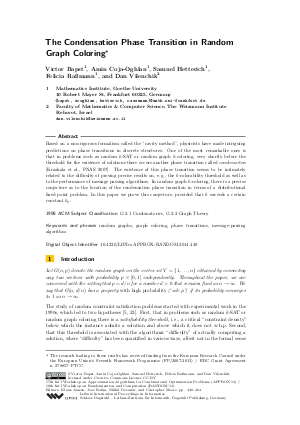The Condensation Phase Transition in Random Graph Coloring
Authors Victor Bapst, Amin Coja-Oghlan, Samuel Hetterich, Felicia Raßmann, Dan Vilenchik
-
Part of:
Volume:
Approximation, Randomization, and Combinatorial Optimization. Algorithms and Techniques (APPROX/RANDOM 2014)
Part of: Series: Leibniz International Proceedings in Informatics (LIPIcs)
Part of: Conference: International Conference on Randomization and Computation (RANDOM)
Part of: Conference: International Conference on Approximation Algorithms for Combinatorial Optimization Problems (APPROX) - License:
 Creative Commons Attribution 3.0 Unported license
Creative Commons Attribution 3.0 Unported license
- Publication Date: 2014-09-04
File

PDF
LIPIcs.APPROX-RANDOM.2014.449.pdf
- Filesize: 0.56 MB
- 16 pages
Document Identifiers
Subject Classification
Keywords
- random graphs
- graph coloring
- phase transitions
- message-passing algorithm
Metrics
- Access Statistics
-
Total Accesses (updated on a weekly basis)
0Document
0Metadata
Abstract
Based on a non-rigorous formalism called the "cavity method", physicists have put forward intriguing predictions on phase transitions in discrete structures. One of the most remarkable ones is that in problems such as random k-SAT or random graph k-coloring, very shortly before the threshold for the existence of solutions there occurs another phase transition called condensation [Krzakala et al., PNAS 2007]. The existence of this phase transition appears to be intimately related to the difficulty of proving precise results on, e.g., the k-colorability threshold as well as to the performance of message passing algorithms. In random graph k-coloring, there is a precise conjecture as to the location of the condensation phase transition in terms of a distributional fixed point problem. In this paper we prove this conjecture for k exceeding a certain constant k0.
Cite As Get BibTex
Victor Bapst, Amin Coja-Oghlan, Samuel Hetterich, Felicia Raßmann, and Dan Vilenchik. The Condensation Phase Transition in Random Graph Coloring. In Approximation, Randomization, and Combinatorial Optimization. Algorithms and Techniques (APPROX/RANDOM 2014). Leibniz International Proceedings in Informatics (LIPIcs), Volume 28, pp. 449-464, Schloss Dagstuhl – Leibniz-Zentrum für Informatik (2014)
https://doi.org/10.4230/LIPIcs.APPROX-RANDOM.2014.449
BibTex
@InProceedings{bapst_et_al:LIPIcs.APPROX-RANDOM.2014.449,
author = {Bapst, Victor and Coja-Oghlan, Amin and Hetterich, Samuel and Ra{\ss}mann, Felicia and Vilenchik, Dan},
title = {{The Condensation Phase Transition in Random Graph Coloring}},
booktitle = {Approximation, Randomization, and Combinatorial Optimization. Algorithms and Techniques (APPROX/RANDOM 2014)},
pages = {449--464},
series = {Leibniz International Proceedings in Informatics (LIPIcs)},
ISBN = {978-3-939897-74-3},
ISSN = {1868-8969},
year = {2014},
volume = {28},
editor = {Jansen, Klaus and Rolim, Jos\'{e} and Devanur, Nikhil R. and Moore, Cristopher},
publisher = {Schloss Dagstuhl -- Leibniz-Zentrum f{\"u}r Informatik},
address = {Dagstuhl, Germany},
URL = {https://drops.dagstuhl.de/entities/document/10.4230/LIPIcs.APPROX-RANDOM.2014.449},
URN = {urn:nbn:de:0030-drops-47168},
doi = {10.4230/LIPIcs.APPROX-RANDOM.2014.449},
annote = {Keywords: random graphs, graph coloring, phase transitions, message-passing algorithm}
}
